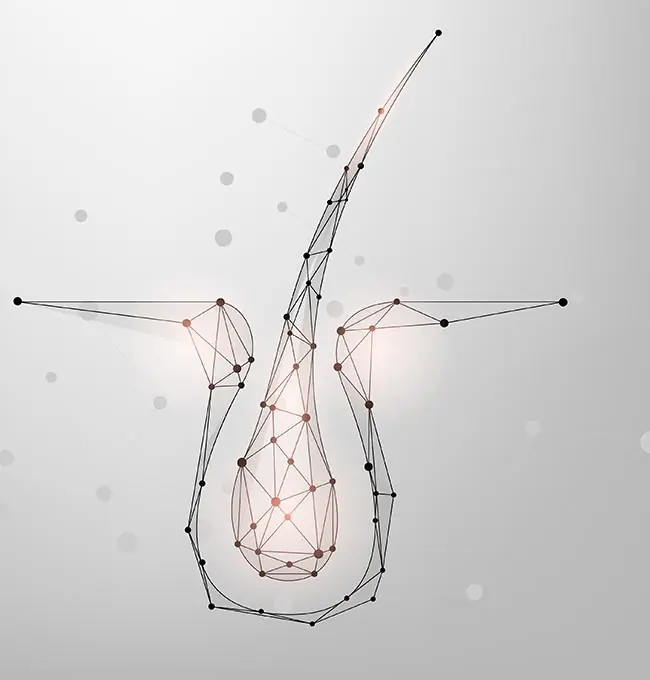Home » Conditions » Skin & hair » Alopecia
Hair is a symbol of seduction, health and vitality. Each individual has on average between 80 000 and 160 000 hairs, which naturally renew themselves over a cycle of 3 to 5 years. Losing 50 to 100 per day is normal. When this shedding increases and regrowth no longer compensates for the loss, it is then referred to as alopecia.
Alopecia, whether it affects women or men, is a common hair condition that often impacts quality of life.
The most frequent form is androgenetic alopecia, which is mainly caused by hormonal and genetic factors.
To sustainably reduce hair loss, treatments have
been developed to complement potential medication such as Minoxidil and Finasteride.
PRP hair treatment, LED hair therapy and hair mesotherapy are methods that improve hair density and stimulate regrowth.

The hair cycle is made up of three phases : the growth phase or anagen (85% of hairs are in this phase), the stabilisation phase or catagen (between 1 and 2% of hairs are in this phase), and the shedding phase or telogen (15% of hairs are in this phase).
During a dermatological examination of the scalp, analysing these phases is important for identifying a possible cause.
Alopecia can be acute (if it lasts less than three months) or chronic (if it lasts more than three months), diffuse or localized.
The causes of acute alopecia are : stress, rapid weight loss, surgery, an infection or acute haemorrhage, postpartum.
The causes of chronic alopecia are : deficiencies (particularly iron deficiency), endocrine disorders, traction alopecia, organ failure, especially kidney failure.
The most common cause of alopecia is androgenetic alopecia.
Some contraceptives have beneficial effects on the hair, while others weaken it and may be responsible for alopecia.
Hormones are important for the health of the hair. They influence its shine, its strength and its tendency to become dry and dull. Hormonal fluctuations can cause a hormonal hair loss.
The hormonal contraception has a direct impact on the appearance of the hair. The composition and the dosage in hormones depend on the type of pill. That is why some oestrogen-progestin pills improve the quality of the hair, while progestin-only pills can lead to its deterioration.
Alopecia can be hereditary. The most common form is androgenetic alopecia, which affects mostly men. Contrary to what one might think, it is not only linked to aging and can appear as early as the age of 20. In men, this type of alopecia usually begins with hair loss at the frontal hairline and the temples.
The hereditary factor plays a major role in androgenetic alopecia. However, hormones, particularly androgens, are also involved. The androgen receptors present in the hair’s dermal papilla disrupt the hair cycle : the growth of the hair is accelerated and the hair becomes increasingly thin before falling out permanently.

Hair loss during menopause is mainly due to hormonal changes that occur during this period. At menopause, the levels of oestrogens and progesterone decrease, disrupting the hormonal balance. The drop in female hormones leads to a relative increase in androgens, the male hormones, which can have an impact on the hair follicles.
The androgens, in fact, reduce the size of the hair follicles, slow down the growth of the hair and accelerate its loss.
Other factors such as stress, nutritional deficiencies and certain medications can contribute to hair loss during menopause.
Hair loss after pregnancy, also called post-partum hair loss, is a common phenomenon. About one third of women may be affected. This type of hair loss is hormonal, triggered by the hormonal changes that occur after childbirth.
During pregnancy, future mothers often notice an improvement in the quality of their hair, which becomes shinier, silkier and grows better due to the increase in oestrogen levels.
After childbirth, the rapid drop in this hormone causes hair loss that can be impressive, which can give the feeling of losing handfuls of hair.
Several other factors can worsen hair loss after childbirth : rapid weight loss, nutritional deficiencies, particularly in iron, stress and fatigue.
The scarring alopecia is a localized form of alopecia that unfortunately is permanent.
It can be caused by an inflammation of the scalp or triggered by a trauma, a burn, or radiotherapy of the scalp.
This hair loss, also known as post-partum telogen effluvium, is caused by intense physical or emotional stress.
During periods of stress, a larger percentage of hair enters prematurely into the resting phase (telogen) and falls out a few months later.
The phenomenon is often temporary and reversible once the stress factor is eliminated.
Traction alopecia is a type of alopecia caused by repeated and excessive tension on the hair follicles.
It is often the consequence of tight hairstyles such as braids, buns and ponytails.
This constant tension damages the follicles, leading to progressive hair loss.
The first signs of traction alopecia are hair thinning and the receding of the frontal hairline. To prevent and treat this condition, it is recommended to reduce tension on the hair by avoiding tight hairstyles.
The most frequent cause of alopecia is androgenetic alopecia of genetic origin, where the hair loss is due to the influence of androgens.
This type of alopecia can affect men from the age of 18 and women from their thirties.
We refer to alopecia in men and alopecia in women.
Two scales represent the stages of progression of the phenomenon, the Hamilton scale for men and the Ludwig scale for women.


The only real prevention consists in treating the cause of the hair loss. However, certain actions help improve the health of the hair :
Hair loss, in women as well as in men, is a common reason for consultation.
Although there are treatments to sustainably reduce hair loss, regrowth is unpredictable and never spectacular.
Certain medical techniques, used alone or in combination, allow patients to regain denser, stronger and healthier hair.
Before considering any treatment, it is essential to identify and correct a possible cause of alopecia.

From an aesthetic point of view, the reference method is represented by PRP injections, particularly hair PRP.
No special preparation is required before the session. Dr. Romano begins by analysing the scalp in order to identify the most weakened areas, even though the entire scalp will be treated.
A blood sample is taken, then the tube is centrifuged for about six minutes to separate the platelet-rich plasma (PRP) from the other blood components. The PRP, concentrated in growth factors, is then collected and injected into the scalp using a mesotherapy technique, with the help of a gun, making the session almost painless.
There are no particular after-effects and resuming daily activities is immediate. However, it is not recommended to take anti-inflammatories or corticosteroids within 48 hours following the session.
The initial protocol includes three sessions spaced three months apart. Afterwards, an annual maintenance session is recommended.

The hair mesotherapy consists in injecting directly into the scalp a blend of vitamins, minerals, amino acids and other essential nutrients. These active ingredients stimulate the hair follicles, locally improve blood circulation and promote cellular regeneration. It also helps slow down hair loss by strengthening the follicles and prolonging their growth phase. The sessions are well tolerated when performed with a gun ; manual injection is more painful and less effective.
After the session, it is recommended to avoid shampooing until the following day, as well as any activity causing significant sweating at the scalp level on the same day.
The protocol includes an initial phase and a maintenance phase. The initial phase consists of six sessions spaced two weeks apart, then three sessions at one-month intervals. The maintenance phase then consists of one session every three to six months.

The LED therapy (light-emitting diodes) is an innovative and non-invasive technique to treat alopecia, with promising results. This method uses specific wavelengths to stimulate the hair follicles and promote hair regrowth.
LED light improves blood circulation, which increases the supply of essential nutrients to the hair follicles. It also helps reduce inflammation and oxidative stress, two factors often associated with hair loss. LED treatment is painless and requires no recovery time.
This treatment can be performed alone or in combination with mesotherapy and PRP sessions.
About twenty sessions are necessary.
Results start to become visible about three months after the beginning of the treatment, as the hair cycle is long. Their extent varies depending on individual response and the method used.
The LED improves scalp blood circulation, reduces inflammation and oxidative stress, and stimulates the hair follicles. It can slightly increase hair density and quality, but regrowth remains very limited.
Mesotherapy strengthens the follicles and prolongs their growth phase thanks to the direct supply of essential nutrients. It improves hair quality, making it thicker and more resistant. It also reduces hair loss, but the regrowth rate remains low.
PRP stimulates tissue regeneration and improves the health of the follicles thanks to growth factors. It reduces hair loss, promotes the thickening of existing hair and can trigger new regrowth cycles, with a regrowth rate that varies depending on the patient.
In Geneva, medical treatments for hair loss are offered at prices that vary depending on the technique used. PRP (Platelet-Rich Plasma), often recommended for its targeted action on hair density, is charged 600 CHF per session. The capillary mesotherapy protocol, also called meso-hair, is offered at 200 CHF per session. These prices apply to each session, and the number of sessions required depends on the type of hair loss, the individual patient profile and the therapeutic strategy adopted.
Patients report a clear improvement in the quality and density of their hair, accompanied by a renewed sense of confidence. They appreciate the non-invasive nature of the treatments and the absence of social downtime. Many point out that combining several techniques provides better results, provided they remain consistent with the follow-up. Nevertheless, as with any medical treatment, the response varies from person to person, hence the need for a personalised evaluation by a doctor.
The best treatment will be decided based on the cause of the alopecia, its severity and the patient’s gender. A consultation with a specialist will make it possible to determine the most suitable treatment.
Yes, hair can grow back after 60, although density and regrowth speed are reduced. Treatments such as PRP, mesotherapy and LED therapy stimulate regrowth.
For women, products containing Minoxidil are often recommended. Natural solutions such as essential oils and dietary supplements provide additional support.
Yes, hair can grow back after alopecia, especially if it is treated quickly and effectively, but there can be no regrowth in the case of scarring alopecia.
Plants such as saw palmetto are sometimes used as natural alternatives to minoxidil to slow down hair loss. Minoxidil is still more effective than a plant.
Androgenetic alopecia can be slowed down with treatments such as Minoxidil, Finasteride (in men), LED therapy, mesotherapy and PRP. A healthy lifestyle and a balanced diet are also important.
It is possible to use cosmetic solutions such as hair powders, wigs, hair extensions or specific hairstyles.
Some forms of alopecia, scarring alopecia for example, are irreversible. However, other types, such as androgenetic alopecia or alopecia areata, can be treated.
Hair loss during the menopause can be slowed by hormone treatments, dietary supplements rich in vitamins and minerals, and topical treatments such as Minoxidil.
To slow down alopecia, an appropriate treatment must be followed : Minoxidil, PRP and mesotherapy. A healthy lifestyle, a balanced diet and stress reduction are also beneficial.
Yes, Minoxidil is clinically proven to be effective in treating hair loss and stimulating hair regrowth.
Possible side effects of Minoxidil include scalp irritation, itching, the appearance of hair on the face and hands and, rarely, palpitations.
Rosemary essential oil is known for its stimulating properties on hair regrowth. Peppermint essential oil and lavender oil are also beneficial.
To thicken fine hair at the menopause, mesotherapy, PRP and Minoxidil are effective. A diet rich in proteins and vitamins is recommended.
A blood test for hair loss should include iron, ferritin, vitamin D, vitamin B12, zinc, thyroid hormones and androgens.
When daily hair loss exceeds physiological loss, i.e. 50-100 hairs a day, it's time to consult a doctor. Signs that may cause concern include loss of hair density, bald patches, itching or irritation of the scalp.
Certain habits are beneficial for the scalp, but they cannot treat alopecia: scalp massages, application of essential oils to the scalp, food supplements and a healthy diet.
Diet : foods rich in proteins, vitamins (biotin, vitamins A, C, D, E) and minerals (iron, zinc, selenium) and good hydration.
Hair care : use gentle hair products without sulfates, parabens or silicones. Avoid excessive heat use (hair dryer, straighteners) and overly tight hairstyles.
Medical treatments if prescribed : Minoxidil and Finasteride.
Natural remedies : essential oils such as rosemary oil.
Dietary supplements containing biotin and vitamins.
PRP hair, hair mesotherapy, LED.
Stress management.